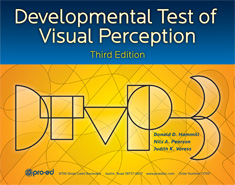Developmental Test of Visual Perception Third Edition provides assessment of visual perception and visual-motor integration.

Developmental Test of Visual Perception | Third Edition
DTVP-3
Developmental Test of Visual Perception Third Edition provides assessment of visual perception and visual-motor integration.
Choose from our formats
Kits
Starter & complete kits, print & digital
1 option
Test forms & reports
Booklets, record forms, answer sheets, report usages & subscriptions
2 options
All products
All tests & materials offered for DTVP-3
3 options